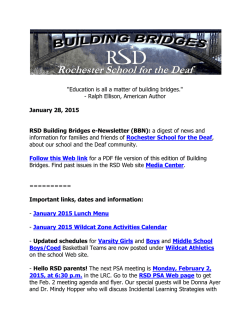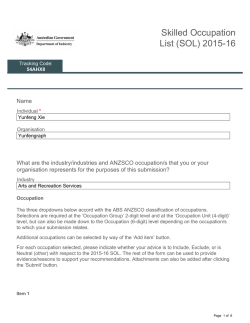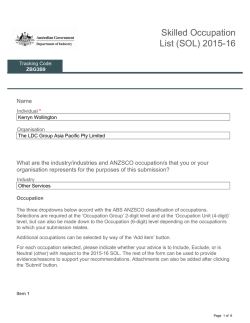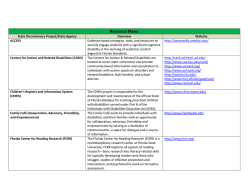
Skilled Occupation List (SOL) 2015-16
Skilled Occupation List (SOL) 2015-16 Tracking Code: M3GNPA Name Individual * Trudy Smith Organisation National Association of Australian Teachers of the Deaf What are the industry/industries and ANZSCO occupation/s that you or your organisation represents for the purposes of this submission? Industry Education and Training Occupation The three dropdowns below accord with the ABS ANZSCO classification of occupations. Selections are required at the ‘Occupation Group’ 2-digit level and at the ‘Occupation Unit (4-digit)’ level, but can also be made down to the Occupation (6-digit) level depending on the occupation/s to which your submission relates. Additional occupations can be selected by way of the ‘Add item’ button. For each occupation selected, please indicate whether your advice is to Include, Exclude, or is Neutral (other) with respect to the 2015-16 SOL. The rest of the form can be used to provide evidence/reasons to support your recommendations. Attachments can also be added after clicking the 'Submit' button. Item 1 Page 1 of 6 Occupation Group * Education Professionals Occupation Unit * Special Education Teachers Occupation Teacher of the Hearing Impaired 241512 Summary advice for 2015-16 SOL * Include Exclude Neutral Are there any occupations that you represent where there is evidence of imbalances in the demand for and supply of skills in the medium-to-long term? * The role of Teacher of the Deaf has a recent history of an imbalance of demand for these skills and the number of teachers who achieve specialist qualifications each year. As with the teaching profession in general, the Teacher of the Deaf field is ageing. This means in the medium to long term many in the profession will be retiring. The number of teachers undertaking the specialist training will not cover the shortfall in expertise. The occurrence of a significant degree of congenital Deafness in the general population of newborns has not changed over the past decade (1:1,000); however, the number of places available for Teacher of the Deaf training has not increased proportionately. In many states of Australia, the number of places available for Teacher of the Deaf training has decreased. Currently, there is no indication that there will be a change in the incidence of Deafness by 2020, or that the proportion of trained Teachers of the Deaf will change by 2020. At present, there are only two institutions (universities) in Australia offering post-graduate degrees to train Teachers of the Deaf and a limited number of places available; NAATD is lobbying for more teachers to be trained and more institutions to offer courses to cater for this training nationwide. The future national rollout of NDIS will further highlight the incidence of deafness and other disabilities within communities which will in turn heighten the need for educators with specialised skills in addressing the educational needs of students who are Deaf or Hard of Hearing. Page 2 of 6 Is there evidence of imbalances in the demand for and supply of skills in the medium-to-long term in non-metropolitan areas? If so, can you indicate in what part of Australia and the number in the occupation in over or undersupply. We have provided three state examples: In South Australia the majority of teachers working as Teacher of the Deaf do not hold this specialist qualification. Scholarships are in place to train teachers once they win a position. This is a continuous process. The under supply in the medium to long term will be across the state currently this is 75 -90 positions. There is a similar level of demand for the services of Teachers of the Deaf in both metropolitan and rural areas of Victoria; however, there is a significant imbalance of supply in rural areas compared to metropolitan areas of the state. Deaf children in some rural regions have had no support from qualified Teachers of the Deaf for their entire schooling. New South Wales regional areas often have issues filling positions with qualified Teachers of the Deaf who are prepared to live in the communities. Itinerant Support Teachers: Hearing in New South Wales may have caseloads of students who are supported in local schools, but there are a number of unfilled positions due to the amount of travel and remoteness in the role. Some areas employ casual teachers without specialist qualifications to see the students, or the students simply miss out. Are there any occupations which require formal licensing or registration arrangements in order to practice/perform in this occupation? For example: • Midwives are required to register with the nurses board in their state or territory • Panelbeaters are required to be registered or certified with the state Motor Vehicle Repair Industry Authority All education staff are required to be registered with their state based teacher registration body (NSW Institute of Teachers, Qld College of Teachers, Teacher Registration Board of SA, Victorian Institute of Teaching) in their state or territory. Western Australia is the only state that requires staff to be a qualified Teacher of the Deaf to apply for a role. Unfortunately, they have just opened a non-qualified recruitment pool of Itinerant teachers due to lack of numbers of qualified staff. However, only fixed term positions are offered to unqualified teachers of the deaf (who hold another teaching qualification). All unqualified teachers must commit to the Teacher of the Deaf Course and upon completion can apply for permanent positions. There is no mandatory requirement to register specifically as a Teacher of the Deaf, nor to seek membership with the National Association of Australian Teachers of the Deaf (NAATD). Some Page 3 of 6 Teacher of the Deaf positions in Victoria, such as those advertised through seek.com, are requesting that applicants show evidence of membership to NAATD. Is it expected that your employment sector will be impacted by any medium-to-long term trends which will impact upon demand and/or supply (excluding costs associated with training, labour hire, and international sponsorship)? Please provide evidence (e.g. data source, policy document) which substantiates these claims. For example: • New benchmarks for childcare centres mandate increased staff-to-child ratios and higher qualification standards for childcare workers. With the advent of Early Newborn Screening for Hearing, many more babies are being diagnosed shortly after birth. It is expected that there will be a greater need for trained Teachers of the Deaf in the early Intervention sector and subsequently in the school sector in the years to come. The introduction of the Federal Government’s Better Start for Children with Disability initiative in July 2011 created a need for trained Teachers of the Deaf to register as providers in this scheme. Families of Deaf children who are eligible for this funding have access to financial support for specialist programs provided by Teachers of the Deaf registered for the scheme. It is anticipated that the sequential roll out of the National Disability Insurance Scheme will increase demand for trained Teachers of the Deaf. The Victorian Department of Education (DEECD) has established the Victorian Deaf Education Institute (VDEI) in response to the deaf education sector’s request to provide increased support for deaf students. Many scholarships and research grants have been made available through VDEI to ensure that more Teachers of the Deaf are trained and are subsequently supported in their ongoing careers. Please provide any other information you consider relevant evidence to support your submission For example, you may know of some independent studies about your occupation that supports your advice to us. The importance of Teachers of the Deaf specialist expertise has been widely recognised in improving educational outcomes for deaf children internationally. For example: Page 4 of 6 Luckner, J. L. (2011). Designing integrated environments that maximize student success: Issues and trends. In D. F. Moores (Ed.), Partners in education: Issues and trends from the 21st international congress on the education of the deaf (pp. 38–49). Washington, DC: Gallaudet University Press. Luckner, J. & Ayantoye, C. (2013). Itinerant teachers of students who are deaf or hard of hearing: Practices and preparation. Journal of Deaf Studies and Deaf Education, 18(3), 411-423. Marschark, M. & Spencer, P.E (2009). Evidence of Best Practice Models and Outcomes in the Education of Deaf and Hard-of-hearing Children: An international review. Center for Education Research Partnerships, National Technical Institute for the Deaf, Rochester Institute of Technology. Spencer, P. E., & Marschark, M. (2010). Evidenced-based practice in educating deaf and hardof-hearing students. New York: Oxford University Press. The National Deaf Children’s Society, England (2013). Protecting specialist education support services for deaf children. Advice for local authorities. Retrieved from http://www.ndcs.org.uk. Would you like to make any additional comments on the SOL? Please provide the name, position and contact details of a person within your organisation who is willing to be contacted if any further information or follow-up is required. Name * Trudy Smith Position * Chairperson Contact details * [email protected] 02)9872 0302 Page 5 of 6 All information, including name and address details, contained in submissions will be made available to the public on the Department of Industry website unless you indicate that you would like all or part of your submission to remain in confidence. Automatically generated confidentiality statements in emails do not suffice for this purpose. Respondents who would like all or part of their submission to remain in confidence should provide this information in an email to SOL@industry. gov.au . Legal requirements, such as those imposed by the Freedom of Information Act 1982, may affect the confidentiality of your submission. Page 6 of 6
© Copyright 2024









